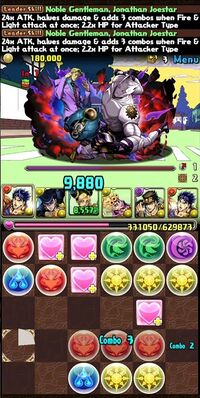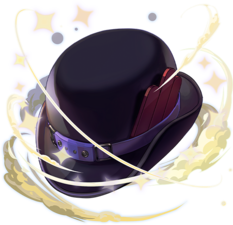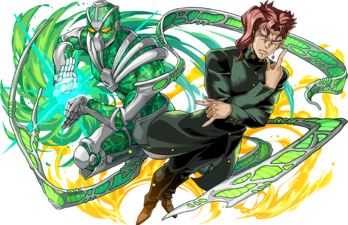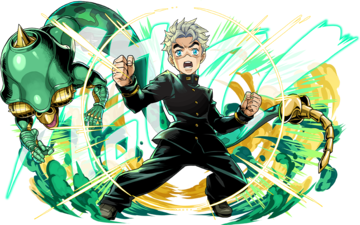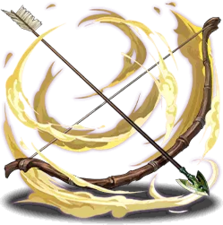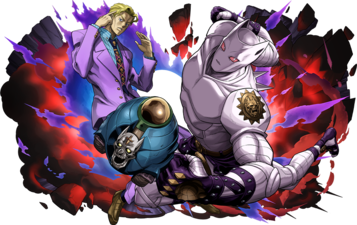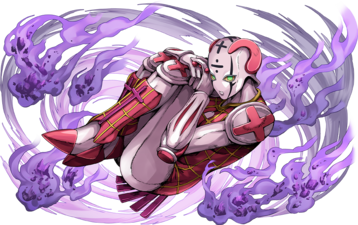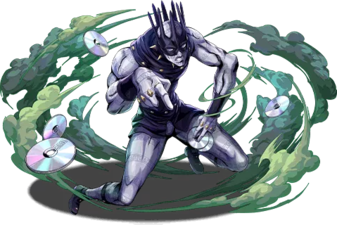Puzzle & Dragons
Puzzle & Dragons (パズル&ドラゴンズ, Pazuru Ando Doragonzu), abbreviated as P&D or Pazudora (パズドラ), is a free-to-play mobile game for Android and iOS developed by GungHo Online Entertainment. On December 21, 2022, a collaboration with the anime JoJo's Bizarre Adventure: The Animation was announced. The collaboration started on December 26, 2022 and ended on January 9, 2023.[1] The English-language North American version of the game received the event 2 months later on March 6, 2023,[2] as did the South Korean version of the game.[3]
Summary
Puzzle & Dragons was originally released in Japan on February 12, 2012. It is a match-three game with gacha game monster-collecting role-playing and strategy elements. It is the first ever mobile game to gross US$1 billion in revenue.
Gameplay
Players collect Monsters (モンスター, Monsutā, individual monsters are often called "cards" in English) through various means to create teams to take on Dungeons (ダンジョン, Danjon) to win in-game currencies and more monsters. The puzzle element of the game takes place in the game's Dungeons where players move tiles called Orbs ("Drops" (ドロップ, Doroppu) in the Japanese version) on a 6-by-5 tile board within a time limit to make as many matches or Combos (コンボ, Konbo) of three or more orbs of the same color that match with the monsters' elemental Attributes (属性, Zokusei, abbreviated to "Att."): Fire, Water, Wood, Light, and Dark. If there are monsters on the player's team that have those Att., they can inflict damage on the Dungeon's enemy monsters; when 3 or 4 Orbs of the same Att. are matched only one enemy monster is hit with the attack, but if 5 or more are matched all enemies on the field are attacked. There are also Heal Orbs to recover HP and hazards such as Jammers that take up space, Poison and Lethal Poison Orbs that reduce the player's HP when matched, and Bombs that if not matched will explode to clear orbs on the board and deduct HP. Orbs can also be augmented such as the Enhanced Orbs which increase the damage multiplier, Combo Orbs that add an additional combo when matched, and Nail Orbs which inflict damage equal to 1% of total enemy HP when matched. There are also hazards such as Weakened Orbs that reduce a combo's damage when matched, Locked Orbs that prevent the orbs from being changed by player or enemy Skills, Roulettes that cause Orbs to change repeatedly throughout a turn, and Thorn Orbs that reduce the player's HP when they are moved by another orb.
Clearing dungeons earns the player experience to increase their Rank (ランク, Ranku). Rank determines several limiting factors for the player's account. First is the total team Cost (コスト, Kosuto); each monster has an inherent Cost generally tied to their rarity with stronger monsters having a higher cost, so newer players cannot immediately use high cost monsters. The next is Stamina (スタミナ, Sutamina), the "currency" used to enter the games' Dungeons; Stamina is replenished over time, currently at a rate of 1 point every 3 minutes. The last limiting factor tied to Rank is the player's Friend List, a list of other players that the player can pair up with in Dungeons; players start out with 20 slots and it caps out at 50 through increasing Rank, but it can be extended past this point through microtransactions up to 300. An independent limiting factor is the total amount of monsters the player is allowed to have in their Monster Box; the current starting amount is 200, and the maximum is 20,000, which is attained through microtransactions, although the monsters considered "items" in the game are not counted towards this total and will stack in the player's box.
Monsters
A monster team comprises a monster designated as the Leader (リーダー, Rīdā), up to four monsters designated as Subs (サブ, Sabu), and a Helper (助っ人, Suketto); the Helpers are pulled from the player's in-game friend list and other players not-yet befriended or players can set one of their unused monsters in the Helper slot on their own team. All monsters possess various stats such as Health Points (HP), Attack (攻撃, Kōgeki, ATK), and Recovery (回復, Kaifuku, RCV), which increase when the monster gains experience to increase its level, either by clearing Dungeons or being fused with other monsters such as a certain class exclusively used for increasing experience. All monsters can also be given +Points to further increase the HP, ATK, and RCV stats to their maximum values (+99 each for a total of +297). Monsters also possess Types (タイプ, Taipu) that are either reflective of their general stat focus (Physical, Attacker, Healer, or Balanced), their design motif (God, Dragon, Devil, or Machine), or their utility as "items" (Evo Material, Enhance Material, Awaken Material, or Redeemable Material).
When a monster reaches its maximum level it can undergo Evolution (進化, Shinka) through using several Evo Material monsters, resetting its level to 1 but upgrading its various stats and sometimes skills as well as changing its artwork; this generally cannot be reversed except with a unique Evolution Material monster. Certain monsters can also undergo Ultimate Evolution (究極進化, Kyūkyoku Shinka), a further evolution that can be performed regardless of the monster's current level so long as it is in its "final" form and this can be reversed and the monster's level is not reset to 1. There are two variants to Ultimate Evolution. The first is Awoken Evolution (覚醒進化, Kakusei Shinka) which requires monsters obtained from Dungeons to evolve (later adjusted to various evolution Gems (希石, Kiseki)), which completely changes the monster's Active Skill. The other is Pixel Evolution (ドット進化, Dotto Shinka) which in addition to changing the monster's Active Skill gives the monster a unique animated pixel artwork. Max level Awoken Evolved monsters (and others) can be further upgraded through Reincarnation Evolution (転生進化, Tensei Shinka), which resets the monster's level back to 1 in exchange for improved stats; Reincarnated monsters at max level can further evolve through Super Reincarnation Evolution (超転生進化, Chō Tensei Shinka), resetting the level to 1 once again and also giving the monster special animated artwork. Various monsters can also undergo Assist Evolution (アシスト進化, Ashisuto Shinka), transforming them into a form that can be used to buff other monsters when applied as an Assist Monster. Introduced in Ver.21.1 is the Ordeal Evolution (試練進化, Shiren Shinka), where the player must use the monster as a team Leader in a specified Ordeal Dungeon and clear the five Ordeals presented in the boss stage, often linked to the Leader's Awoken Skills; the selected monster's level is reset back to 1 and is given a brand new Skill that has a spoken voice line and a full screen animation.
Most monsters at the maximum level of 99 can be further improved by fusing a unique Enhance Material monster to perform a Level Limit Break (レベル限界突破, Reberu Genkai Toppa), uncapping their maximum level to reach 110 instead; the only ones excluded from this mechanic are monsters whose max level is not 99, those with Transformation mechanics, and certain new monsters with a third Att. in their base form. Monsters with Level Limit Break at level 110 can be further upgraded with 5 of the Enhance Material monsters to perform a Level Super Limit Break (レベル超限界突破, Reberu Chō Genkai Toppa) that further increases the level cap to 120; at this stage certain buffs from some Latent Awoken Skills are passively applied, allowing the monster to surpass the maximum damage value.
Skills

All monsters also possess various kinds of skills, either active or passive, that affect the Dungeon gameplay.
Skills (スキル, Sukiru, often informally called an "Active Skill" to differentiate it from the others) can be used by the player during a Dungeon with varying effects such as changing the Att. of Orbs on the board, directly inflicting damage to the enemy monster(s), buffing the player's team's stats, or recovering HP or other statuses such as various Binds. Some newer monsters also have a mechanic called Skill Evolution (スキル進化, Sukiru Shinka) that changes the Skill for the remainder of the Dungeon and other monsters have skills that Transform (変身, Henshin) the monster itself for the rest of the dungeon with new stats, Skills, and other features (in some cases both of these features can loop around to the original status). Every Skill has a Skill Level, which determines the cooldown for its use. For the most part, monsters can increase the Skill Level by fusing monsters with the same Skill onto it or entering dungeons where monsters with the same skill can be encountered, but there is not usually a guaranteed chance for the Skill Level to increase; guaranteed Skill Level Ups only happen by using a Lv.99 duplicate of the base monster as fusion material or special Enhance Material monsters that guarantee it under various criteria. Any monster that does not have a Skill Evolution or Transform type Skill can also be set as an Assist (アシスト, Ashisuto), giving the base monster a second Skill to use in Dungeons; to use the Assist's Skill, both Skills' cooldown must be reached and the base Skill must be unused.
A Leader Skill (リーダースキル, Rīdā Sukiru) is a set of criteria that are applied by the monsters in the Leader and Helper slots. These generally apply buffs to the team as a whole when the various criteria they describe are met. The most basic of these are simply applying a passive buff to various stats so long as monsters in the team are of a certain Att. or Type. More complex Leader Skills often require a certain number of Att. Orbs matched in a single Combo, a certain number of Combos achieved on a single turn, or a certain number of Combos of a specific Att. made in a single turn. Some Leader Skills also passively set the total board size to 7-by-6, restrict the Orb Movement time limit, prevent the board from refilling during the player's turn, or change the minimum number of Orbs a player must match to make a Combo often in exchange for higher buffs.
Awoken Skills (覚醒スキル, Kakusei Sukiru) are unlocked on monsters through the use of Awaken Material monsters, but also using identical copies of the base monster as fusion material. They have a similar variety of applications as leader skills, ranging from passive buffs to the card's stats, enemy skill or damage resistances, or Orb matching criteria for buffs and other effects. Some of the final category include the Two-Pronged Attack to hit two enemies at once when matching exactly 4 Orbs, [L] Increased Attack that removes the Orb Locked status for matching exactly 5 Orbs in an L-shape, and Recover Bind which reduces the Bind status when matching Heal Orbs in a horizontal row. Monsters can also possess Type Killers that increase the base damage done to enemy monsters of a certain Type, Skill Boosts which reduce the initial Skill Level cooldown at the start of a Dungeon, Time Extends which increase the base time allowed for moving Orbs on the board and the Awoken Assist which applies all of the card's Awoken Skills onto the base monster when it is used as an Assist.
Monsters that have undergone Level Limit Break and at the +Point cap of 297 can be given a Super Awoken Skill (超覚醒スキル, Chōkakusei Sukiru), an additional Awoken Skill chosen from a preset pool per monster. All copies of the card have the same pool and many Ultimate Evolutions also share the pool as their base forms, but players can give different copies different Super Awoken Skills. Players initially had to give the monster an additional 297 +Points to have one of these Super Awoken Skills chosen at random, but a mechanic was later added that let players choose a specific Super Awoken Skill at a higher +Point and an additional Awaken Material monster cost depending on the size of the card's Super Awoken Skill pool. With Version 21.6, a new Sync Awakening (シンクロ覚醒, Shinkuro Kakusei) mechanic was added that gives transforming monsters additional Awoken Skills not unlike Super Awoken Skills, but it only provides one option and requires the player possess other monsters at certain Exp. and Skill Levels to unlock.
Further supplementing these Awoken Skills are the Latent Awoken Skills (潜在覚醒スキル, Senzai Kakusei Sukiru), applied by fusing with a specific Awaken Material monster and giving the monster an additional set of passive skills. These are unique from the other Awoken Skills and monsters that do not have any Awoken Skills can still be given a Latent Awoken Skill. Every monster has 6 Latent Awoken slots (originally 5 that could be upgraded to 6, and now further upgradeable to 8 on certain monsters) and Latent Awoken Skills can take up either 1, 2, or all 6 (base) slots. The 6-slot Latent Awoken Skills in particular are often used to resist various stage hazards or clear them so long as the monster has a specific standard Awoken Skill; if the monster with a 6-slot Latent Awoken Skill has undergone Level Super Limit Break, the Latent Awoken Skill applies a 1.5x, 1.8x, 2x, or 3x multiplier on the maximum damage cap.
Dungeons
Dungeons cost the player Stamina to run, which recharges 1 point per 3 minutes or it can be completely restored through either microtransactions or in more recent years watching an in-game advertisement. There are 6 standard groups of Dungeons in the game: Normal, Technical, Special, Ranking, Quest, and Story Dungeons.
- Normal Dungeons are the first set available to players, and enemy monsters simply attack the player monster with set damage outputs. "Normal" is also a category of dungeon in general.
- Technical Dungeons are unlocked after clearing a certain tier of Normal Dungeons, and feature enemy monsters possessing their own skills to hamper the player as well as having varying damage outputs depending on their own HP. Like "Normal", "Technical" is a general category of dungeon. Technical Dungeons can be further split up into varying categories:
- Special (特殊, Tokushū): All monsters on the team have their level set to 1 and by progressing through the dungeon the level is increased based on the turns used to defeat a floor and the monster's Team Cost.
- Supergravity (超重力, Chōjūryoku): The player's ATK is reduced to a certain percentage announced at the start of the Dungeon. Monsters with the Levitation Awoken Skill are given a lesser percentage reduction.
- Superaltitude (超高度, Chōkōdo): The player's RCV is reduced to a certain percentage announced at the start of the Dungeon.
- Special Dungeons are a set of rotating Normal and Technical Dungeons that provide the player the chance to get rare monsters for limited periods of time. These are further divided into:
- Limited-Time (ゲリラ, Gerira, lit. "Guerrilla"): Dungeons that only appear for an hour to a couple hours at a time at a different time during the day for every player.
- Descended (降臨, Kōrin): Dungeons featuring one-off rare monsters that can be obtained after clearing the Dungeon, often as powerful as monsters obtained from the Rare Egg Machines.
- Ordeal (試練, Shiren): Added in Version 21.1, Ordeal Dungeons allow certain monsters to evolve if they are set as the team leader for the dungeon and if the player can pass a skill test at the end that uses the leader's Awoken Skills.
- P&D Pass (パズドラパス, Pazudora Pasu): The P&D Pass is a subscription service that adds additional Special Dungeons for the player. Every day, a single dungeon is provided that awards a Magic Stone and rewards including set Evolution and Awaken Material monsters, increased Rank Experience, and free monsters usually relegated to the God Fest events mentioned below; the quality and sometimes quantity of the rewards increases with time subscribed to the service capping at the 5th month. Additionally, players are given access to sets of dungeons available at all times, such as the daily Evolution Material monster dungeons and all of the Descended Dungeons.
- Ranking Dungeons test players' skills against each other, earning points based on how they cleared the Dungeon such as time elapsed, number of turns taken, and certain Awoken Skills activated; with the top players of the whole server earning a Crown icon next to their in-game name. Some Ranking Dungeons have preset teams while others allow the player to develop a team of their own.
- A subset of Ranking Dungeons are called Fevers and use a mechanic that incorporates a mechanic from Puzzle & Dragons W that gives players a limited amount of time to make as many combos as possible and earn as much points as possible by playing the level as long as possible, with only certain Att. Orbs dealing damage to the enemy monster which changes each run; points and overall player rank are cumulative, with players encouraged to reach the point cap.
- Quest Dungeons are a monthly rotating set of Dungeons of increasing difficulty, with clearing individual Dungeons and whole blocks of the Quest Dungeons rewarding players unique "Material" Type monsters. These were originally a set of 10 dungeons with unique lineups before incorporating several of the Descended Dungeons in the sets, making them available for the entire month. The current format in 2023 has introduced a set of 15 dungeons of increasing difficulty, adding the "Supergravity" and "Superaltitude" status to several, and awarding the player increasing amounts of Magic Stones with each level cleared.
- Story Dungeons feature more RPG-oriented mechanic where players progress through storylines with written dialogue and certain player restrictions. The general reward for each Story Dungeon is a unique Evolution Material monster to get a new Evolution form for the main character of the Dungeon.
A Multiplayer Dungeon category is also available.
- In the 2-Player Mode, players share their Leaders while taking turns using their own team to clear Dungeons. Every Special and Technical Dungeon is available in 2-Player Mode.
- In the 3-Player Mode, players must pick their own Helper while taking turns to clear Dungeons. Only a specific set of Dungeons are available in 3-Player Mode, including a rotating selection of the Special Dungeons such as Descended Dungeons and special event Colosseum Dungeons.
- The 8-Player Mode is a PVP mode where players use the same preset team of monsters to take on the same dungeon, often with unique Skills and Leader Skills just established for the 8-Player Mode dungeon, such as Skills that actively hamper other players' gameplay. Players compete against each other in a scoring system similar to the Ranking Dungeons, with bonus points applied to players who had records for number of Combos, damage output, and extra points criteria met. Players can also choose an Icon from any monster in their Monster Book for cosmetic purposes.
- A 4-Player Mode was added in late 2023, acting as another PVP-style mode where players are instead challenged to meet the requirements of a unique Dungeon divided into the kinds of Leader Skills or Awoken Skills required to clear it. Players are given a set leader while they must choose from a pool of 15 out of 35 monsters to use as subs. Additionally, players have an Icon they can use that marks their progress in the Dungeon screen; later updates to this mode gave the Icon a unique Active Skill to assist in the Dungeon itself and several Collaboration Events have limited time Icons to purchase through microtransactions.
Progression
Monsters in the game have various inspirations from generic fantasy monsters such as goblins, ogres, slimes, and dragons to being inspired by various real world mythologies, religions, and historical figures. Monsters are variably obtained through winning them in Dungeons or winning them through the Egg Machines (ガチャ, Gacha). The Rare Egg Machines are paid for with Magic Stones (魔法石, Mahōseki) obtained through either clearing Dungeons, special events, or microtransactions. A separate Pal Egg Machine also exists where players spend Pal Points (友情ポイント, Yūjō Pointo), obtained through consecutive daily logins and using other players' monsters as Helpers when clearing dungeons, to win various Material monsters. Players are encouraged to use the Rare Egg Machines during special twice-monthly events called God Fests (ゴッドフェス, Goddo Fesu) where the various "God" monsters have an increased chance of being won from the Rare Egg Machine. There are also special God Fest Exclusive monsters that can otherwise not be obtained in normal gameplay.If players sell their monsters they can earn a currency called Monster Points that they can then spend at the Purchase Monster (モンスター購入, Monsutā Kōnyū) store. Players can also trade in monsters at the Monster Exchange (モンスター交換所, Monsutā Kōkansho), obtaining unique monsters or special Evolution Materials.
Puzzle & Dragons also holds several events throughout the year that accompany exclusive Special Dungeons and Rare Egg Machines dedicated to just the monsters from the event. These include various holiday-themed events such as ones for Halloween and Christmas as well as events surrounding special original characters such as the Dragonbounds & Dragon Callers or the Star-Twined Fairies. The Purchase Monster and Monster Exchange stores will have unique offerings during these events, such as being given the option to trade in God Fest Exclusive and event exclusive monsters in for other event exclusive monsters. The Magic Stone shop will also feature unique bundles during these events, offering the player the chance to get monsters from a smaller pool of higher rarity units or a specific unit, often one that additionally unlocks Orbs Skin (きせかえドロップ, Kisekae Doroppu) and BGM Set (BGMセット, Bījīemu Setto) customizations for Dungeon gameplay.
In addition to the holidays and special events, there are also often Collaboration (コラボ, Korabo, often abbreviated to "Collab") events which feature characters from various third-party intellectual properties such as other video games, anime, manga, and movies. The Collab events have their own unique Dungeon, Rare Egg Machine, Purchase Monster, Monster Exchange, and Magic Stone shop bundle lineups, with the Orbs Skins and BGM Sets as well. Some recurring collaborations in Puzzle & Dragons have included the Final Fantasy series, the Ultraman series, Sanrio's many characters like Hello Kitty, and GungHo's other video game properties such as Summons Board, Chrono Ma:gia, Ninjala, and Ragnarok Online.
Franchise
Puzzle & Dragons has also spawned a franchise of other video games and multimedia since its initial release in 2012:
- Puzzle & Dragons Challenge, a companion app used in early esports ventures featuring time attack challenges with preset teams.
- Puzzle & Dragons Z, a Nintendo 3DS game using P&D mechanics for a puzzle adventure RPG with towns and dungeons that removed microtransaction elements found in the mobile game.
- Puzzle & Dragons Battle Tournament, an arcade game published in cooperation with Square Enix that implemented online player-vs-player gameplay and game saves tied to a subscription card; the game also used an 8-by-5 tile board compared to the mobile version.
- Puzzle & Dragons W, a side-game added to the main P&D app featuring the mascot TAMADRA character and introducing a different gameplay style of having set Orb-matching criteria for each level on a 6-by-6 tile board; removed from the game application in July 2020.
- Puzzle & Dragons Z Tamer Battle, an arcade game version of Puzzle & Dragons Z integrated with a collectible card game sold by the arcade cabinets.
- Puzzle & Dragons Trading Card Game, a trading card game featuring characters and elements from the mobile game; now out of print.
- Puzzle & Dragons: Super Mario Bros. Edition, a Nintendo 3DS game featuring gameplay similar to Puzzle & Dragons Z but only featuring characters from Nintendo's Mario franchise. When released outside of Japan both Puzzle & Dragons Z and Super Mario Bros. Edition were bundled together as a single game.
- Puzzle & Dragons Radar, a companion app which incorporated GPS and augmented reality features, allowing players to search for items around them as well as read QR codes sold on various pieces of collectible merchandise on to transfer items, monsters, and dungeons to the main P&D game. At in-person P&D events the app is used to distribute unique monsters to attendees. It later added its own in-game dungeon and battle system used in esports events; in 2020 it underwent a major update to be rebranded as Puzzle & Dragons Battle and now incorporates a Season Pass system for unique Leader Monsters.
- Puzzle & Dragons X, a Nintendo 3DS game serving as a successor to P&DZ with the same adventure RPG elements, this time split into two versions: Book of God and Book of Dragon. This also spawned an anime television series based on the plot of the game and several pieces of collectible merchandise such as Armor Drops which could be scanned by the 3DS's camera to add the monsters to the player's game; these could also be read by Puzzle & Dragons Radar to be transferred over to the mobile game.
- PazuDora, a follow-up TV anime series this time based on the expanded Puzzle & Dragons Radar esports features; Monster Memories featured in the anime were sold as merchandise and integrated into P&DR as well as Monster Memory Cards that were also integrated into P&DR.
- Puzzle & Dragons Gold, a Nintendo Switch title featuring characters from the PazuDora anime and gameplay mechanics from P&DR/P&DB and two-player multiplayer.
- Puzzle & Dragons Nintendo Switch Edition, another Nintendo Switch title featuring gameplay more similar to the original mobile game but with microtransaction elements and up to 8-player online multiplayer and custom Dungeon design elements, the latter of which has had several design competitions staged which then influenced new Dungeons and Evolutions in the mobile game.
- Puzzle & Dragons Story, released worldwide on Apple Arcade on December 5, 2023, featuring gameplay similar to that of Nintendo Switch Edition but with a storyline not unlike that of the Story Dungeons in the original mobile game.
JoJo's Bizarre Adventure Collaboration
On December 21, 2022, the official Japanese Puzzle & Dragons YouTube channel held a live broadcast to mark the end of 2022 and of their year-long 10-year anniversary festivities. During the broadcast, they had a surprise announcement of a collaboration featuring characters from JoJo's Bizarre Adventure: The Animation, which was coincidentally also celebrating its 10-year anniversary in 2022. The in-game event began the following Monday December 26, 2012, allowing players of P&D to obtain characters featured in the JoJo's Bizarre Adventure anime through a special 10 Magic Stone Collaboration Egg Machine, Special Dungeons, a Descend Dungeon featuring Enrico Pucci, a boss rush dungeon called "JoJo's Bizarre Adventure Stand Rush!", and a time attack version of the boss rush called the "[JOJO] Title Challenge!" that would award players the special Title (称号, Shōgō) ![]() based on the JoJo's Bizarre Adventure: The Animation logo to put next to their username in game. The event concluded in Japan on January 9, 2023. The event was also held concurrently on the shared P&D servers for Hong Kong and Taiwan.
based on the JoJo's Bizarre Adventure: The Animation logo to put next to their username in game. The event concluded in Japan on January 9, 2023. The event was also held concurrently on the shared P&D servers for Hong Kong and Taiwan.
Monsters in the collaboration event feature the special Skill Voice (スキルボイス, Sukiru Boisu) Awoken Skill that plays a short soundbyte when the card's Active Skill is used; if the base Skill is used (rather than an Assist's Skill), it also adds a special Cut-In animation effect. Players who obtain Jolyne Cujoh for the first time through the Egg Machine would be awarded a JoJo's Bizarre Adventure Orbs Skin while players who obtain Dio Brando from the Egg Machine for the first time would be awarded the JoJo's Bizarre Adventure BGM Set featuring the music used in the game's Special Dungeons. Several Magic Stone bundles were also sold through microtransactions in the event: during each week players could purchase a 3 Magic Stone set bundled with a free pull from the Collaboration Egg Machine and a 30 Magic Stone set bundled with a free pull that guaranteed ★7 rarity unit, with single time purchases available for a 20 Magic Stone set bundled with a guaranteed Jolyne Cujoh and a 30 Magic Stone set bundled with a guaranteed Dio Brando, enabling players to get the Orbs Skin and BGM Set.
On February 28, 2023, the official North American P&D YouTube channel announced that the North American edition of P&D would also gain access to the JoJo's Bizarre Adventure Collaboration Event. Two days later on March 2, 2023, it was announced on the official website that the event would last March 6 to March 19, 2023; the 3 Magic Stone bundles listed above were reduced to 2 Magic Stones on the North American server. The Korean publisher of the game Gravity NeoCyon released that they would also be receiving the JoJo's Bizarre Adventure event lasting from March 6 to March 20, 2023.
JoJo Characters
DISCs
The JoJo's Bizarre Adventure Collab DISC (ジョジョの奇妙な冒険コラボDISC, JoJo no Kimyō na Bōken Korabo Disuku) monsters are obtained from the special JoJo's Bizarre Adventure and "Father Pucchi Descended!" Special Dungeons in the game. Players collect them to trade in for various monsters in the event such as the higher rarities of the DISCs or the Bow and Arrow unit.
Event History
| Event | Description
|
|---|
First run of the event on the Japanese server.
First run of the event on the Hong Kong/Taiwanese server.
First run of the event on the North American server.
First run of the event on the South Korean server.
Gallery
Videos
See also
Notes
- ↑ The Bow and Arrow card in Puzzle & Dragons is technically a non-evolving monster, but its utility is the same as the other Assist Evolution stage monsters.
References
